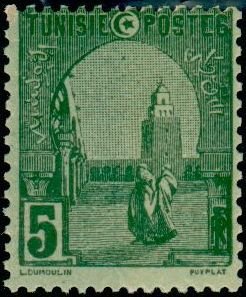Stamp: Mosque of Kairouan (Tunisia 1906)
Mosque of Kairouan (Tunisia 1906)
01 January (Tunisia ) within release Country motives goes into circulation Stamp Mosque of Kairouan face value 5 Tunisian centime
| Stamp Mosque of Kairouan in catalogues | |
|---|---|
| Michel: | Mi:TN 32 |
| Yvert et Tellier: | Yt:TN 31 |
Stamp is square format.
Also in the issue Country motives:
- Stamp - Mosque of Kairouan face value 1;
- Stamp - Mosque of Kairouan face value 2;
- Stamp - Mosque of Kairouan face value 5;
- Stamp - Farmer face value 10;
- Stamp - Farmer face value 15;
- Stamp - Farmer face value 20;
- Stamp - Farmer face value 25;
- Stamp - Hadrian aqueduct, Zaghouan face value 35;
- Stamp - Hadrian aqueduct, Zaghouan face value 40;
- Stamp - Hadrian aqueduct, Zaghouan face value 75;
- Stamp - Carthaginian galley face value 1;
- Stamp - Carthaginian galley face value 2;
- Stamp - Carthaginian galley face value 5;
Stamp Mosque of Kairouan it reflects the thematic directions:
Mosquitoes, the Culicidae, are a family of small flies consisting of 3,600 species. The word mosquito (formed by mosca and diminutive -ito) is Spanish and Portuguese for little fly. Mosquitoes have a slender segmented body, one pair of wings, three pairs of long hair-like legs, and specialized, highly elongated, piercing-sucking mouthparts. All mosquitoes drink nectar from flowers; females of some species have in addition adapted to drink blood. The group diversified during the Cretaceous period. Evolutionary biologists view mosquitoes as micropredators, small animals that parasitise larger ones by drinking their blood without immediately killing them. Medical parasitologists view mosquitoes instead as vectors of disease, carrying protozoan parasites or bacterial or viral pathogens from one host to another.
The United Nations Educational, Scientific and Cultural Organization (UNESCO; pronounced /juːˈnɛskoʊ/) is a specialized agency of the United Nations (UN) with the aim of promoting world peace and security through international cooperation in education, arts, sciences and culture. It has 194 member states and 12 associate members,as well as partners in the non-governmental, intergovernmental and private sector. Headquartered in Paris, France, UNESCO has 53 regional field offices and 199 national commissions

